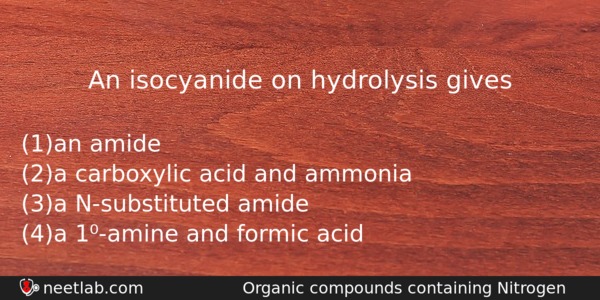| ⇦ | 
| ⇨ |
An isocyanide on hydrolysis gives
Options
(a) an amide
(b) a carboxylic acid and ammonia
(c) a N-substituted amide
(d) a 1⁰-amine and formic acid
Correct Answer:
a 1⁰-amine and formic acid
Explanation:
No explanation available. Be the first to write the explanation for this question by commenting below.
Related Questions: - In an organic compound phosphorus is estimated as
- Which of the following is a primary halide
- One of the following that cannot undergo dehydrohalogenation is
- Enantiomers
- Gasoline has composition
Topics: Organic compounds containing Nitrogen
(87)
Subject: Chemistry
(2512)
Important MCQs Based on Medical Entrance Examinations To Improve Your NEET Score
- In an organic compound phosphorus is estimated as
- Which of the following is a primary halide
- One of the following that cannot undergo dehydrohalogenation is
- Enantiomers
- Gasoline has composition
Topics: Organic compounds containing Nitrogen (87)
Subject: Chemistry (2512)
Important MCQs Based on Medical Entrance Examinations To Improve Your NEET Score
18000+ students are using NEETLab to improve their score. What about you?
Solve Previous Year MCQs, Mock Tests, Topicwise Practice Tests, Identify Weak Topics, Formula Flash cards and much more is available in NEETLab Android App to improve your NEET score.
Share this page with your friends

Leave a Reply